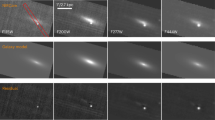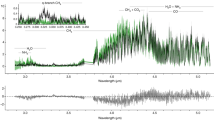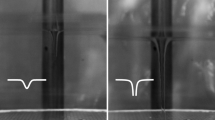Abstract
Venus, unlike Earth, is an extremely dry planet although both began with similar masses, distances from the Sun, and presumably water inventories. The high deuterium-to-hydrogen ratio in the venusian atmosphere relative to Earth’s also indicates that the atmosphere has undergone significantly different evolution over the age of the Solar System1. Present-day thermal escape is low for all atmospheric species. However, hydrogen can escape by means of collisions with hot atoms from ionospheric photochemistry2, and although the bulk of O and O2 are gravitationally bound, heavy ions have been observed to escape3 through interaction with the solar wind. Nevertheless, their relative rates of escape, spatial distribution, and composition could not be determined from these previous measurements. Here we report Venus Express measurements showing that the dominant escaping ions are O+, He+ and H+. The escaping ions leave Venus through the plasma sheet (a central portion of the plasma wake) and in a boundary layer of the induced magnetosphere. The escape rate ratios are Q(H+)/Q(O+) = 1.9; Q(He+)/Q(O+) = 0.07. The first of these implies that the escape of H+ and O+, together with the estimated escape of neutral hydrogen and oxygen, currently takes place near the stoichometric ratio corresponding to water.
This is a preview of subscription content, access via your institution
Access options
Subscribe to this journal
Receive 51 print issues and online access
$199.00 per year
only $3.90 per issue
Buy this article
- Purchase on Springer Link
- Instant access to full article PDF
Prices may be subject to local taxes which are calculated during checkout



Similar content being viewed by others
Change history
09 May 2022
A Correction to this paper has been published: https://doi.org/10.1038/s41586-022-04621-4
References
Donahue, T. M., Grinspoon, D. H., Hartle, R. R. & Hodges, R. R. in Venus II: Geology, Geophysics, Atmosphere, and Solar Wind Environment (eds Bougher, W. W., Hunten, D. M. & Phillips, R. J.) 385–414 (Univ. of Arizona Press, Tucson, AZ, 1997)
Nagy, A. F., Cravens, T. E., Lee, J. H. & Stewart, A. I. P. Hot oxygen atoms in the upper atmosphere of Venus. Geophys. Res. Lett.8, 629–632 (1981)
Mihalov, J. D. & Brace, A. The distant interplanetary wake of Venus: Plasma observations from Pioneer Venus. J. Geophys. Res.87, 9045–9053 (1982)
Intrilligator, D. S., Wolf, J. H. & Michalov, J. D. The Pioneer Venus orbiter plasma analyzer experiment. IEEE Trans. Geosci. Remote Sens.GE-18, 39–43 (1980)
Kasprzak, W. T., Niemann, H. B., Hedin, A. E., Bougher, S. W. & Hunten, D. M. Neutral composition measurements by the Pioneer Venus neutral mass spectrometer during re-entry. Geophys. Res. Lett.20, 2747–2750 (1993)
Intriligator, D. S. Results of the first statistical studies of Pioneer Venus plasma observations in the distant Venus tail: Evidence for a hemispheric asymmetry in the pickup of ionospheric ions. Geophys. Res. Lett.16, 167–170 (1989)
Barabash, S. et al. The Analyser of Space Plasmas and Energetic Atoms (ASPERA-4) for the Venus Express mission. Planet. Space Sci.55, 1772–1792 (2007)
Zhang, T. L. et al. Magnetic field investigation of the Venus plasma environment: expected new results. Planet. Space Sci.54, 1336–1343 (2006)
Zhang, T. L. et al. Little or no solar wind enters Venus’ atmosphere at solar minimum. Nature 10.1038/nature06026 (this issue).
Brace, L. H., Theis, R. F. & Hoegy, W. R. Plasma clouds above the ionopause of Venus and their implications. Planet. Space Sci.30, 29–37 (1982)
Hartle, R. E. & Grebowsky, J. M. Planetary loss from light ion escape on Venus. Adv. Space Res.15, 117–122 (1995)
Luhmann, J. G., Ledvina, S. A., Lyon, J. G. & Russell, C. T. Venus O+ pickup ions: Collected PVO results and expectations for Venus Express. Planet. Space Sci.54, 1457–1471 (2006)
Fox, J. L. Advances in the aeronomy of Venus and Mars. Adv. Space Res.33, 132–139 (2004)
Lammer, H. et al. Loss of hydrogen and oxygen from the upper atmosphere of Venus. Planet. Space Sci.54, 1445–1456 (2006)
McElroy, M. B., Prather, M. J. & Rodriguez, J. M. Loss of oxygen from Venus. Geophys. Res. Lett.9, 649–651 (1982)
von Zahn, U., Kumar, S., Niemann, H. & Prinn, R. in Venus (eds Hunten, D. M., Colin, L., Donahue, T. M. & Moroz, V. I.) 299–430 (Univ. of Arizona Press, Tucson, AZ, 1983)
Lammer, H. et al. Loss of water from Mars: Implications for the oxidation of the soil. Icarus165, 9–25 (2003)
Luhmann, J. G., Kasprzak, W. T. & Russell, C. T. Space weather at Venus and its potential consequences for atmosphere evolution. J. Geophys Res.112 E04s10 10.1029/2006JE002820 (2007)
McComas, D. J., Spence, H. E., Russell, C. T. & Saunders, M. A. The average magnetic field draping and consistent plasma properties of the Venus magnetotail. J. Geophys. Res.91, 7939–7953 (1986)
Barabash, S., Fedorov, A., Lundin, R. & Sauvaud, J.-A. Martian atmospheric erosion rates. Science315, 501–503 (2007)
Krasnopolsky, V. A. & Gladstone, G. R. Helium on Mars and Venus: EUVE observations and modeling. Icarus176, 395–407 (2005)
Zhang, T. L., Luhmann, J. G. & Russell, C. T. The solar cycle dependence of the location and shape of the Venus bow shock. J. Geophys. Res.95, 14961–14967 (1990)
Zhang, T. L., Luhmann, J. G. & Russell, C. T. The magnetic barrier at Venus. J. Geophys. Res.96, 11145–11153 (1991)
Acknowledgements
We thank the European Space Agency for providing the Venus Express opportunity, and national space agencies and organizations for supporting the investigators who contributed to the success of the Venus Express plasma package.
Author Contributions S.B. is the principal investigator of the Venus Express plasma package, Analyser of Space Plasmas and Energetic Atoms (ASPERA)-4. J.A.S. is the co-principal investigator. A.F. is the leading co-investigator of the ion mass analyser of ASPERA-4. A.C. is the leading co-investigator of the electron spectrometer of ASPERA-4. T.L.Z. is the principal investigator of the magnetometer. The remaining authors are co-investigators on either of the plasma analyser or the magnetometer investigations.
Author information
Authors and Affiliations
Corresponding author
Supplementary information
Supplementary Information
The file contains additional information for figure legends. (PDF 27 kb)
Rights and permissions
About this article
Cite this article
Barabash, S., Fedorov, A., Sauvaud, J. et al. The loss of ions from Venus through the plasma wake. Nature 450, 650–653 (2007). https://doi.org/10.1038/nature06434
Received:
Accepted:
Published:
Issue Date:
DOI: https://doi.org/10.1038/nature06434
This article is cited by
-
Synergies Between Venus & Exoplanetary Observations
Space Science Reviews (2023)
-
The Habitability of Venus
Space Science Reviews (2023)
-
Venus Evolution Through Time: Key Science Questions, Selected Mission Concepts and Future Investigations
Space Science Reviews (2023)
-
The Long-Term Evolution of the Atmosphere of Venus: Processes and Feedback Mechanisms
Space Science Reviews (2022)
-
Two-stream plasma instability as a potential mechanism for particle escape from the Venusian ionosphere
Pramana (2022)
Comments
By submitting a comment you agree to abide by our Terms and Community Guidelines. If you find something abusive or that does not comply with our terms or guidelines please flag it as inappropriate.



